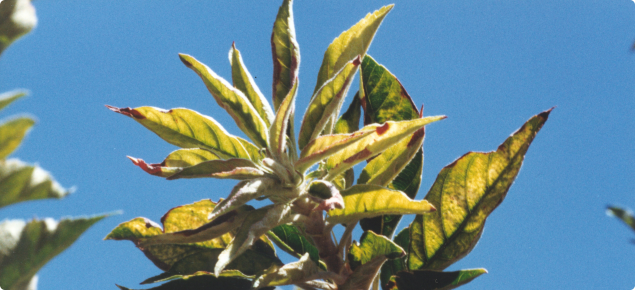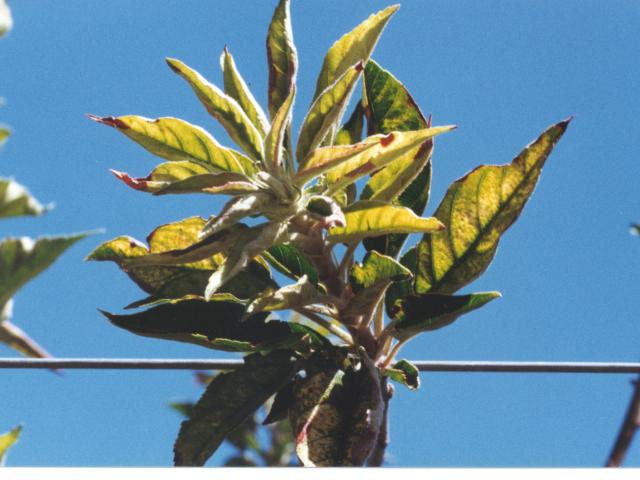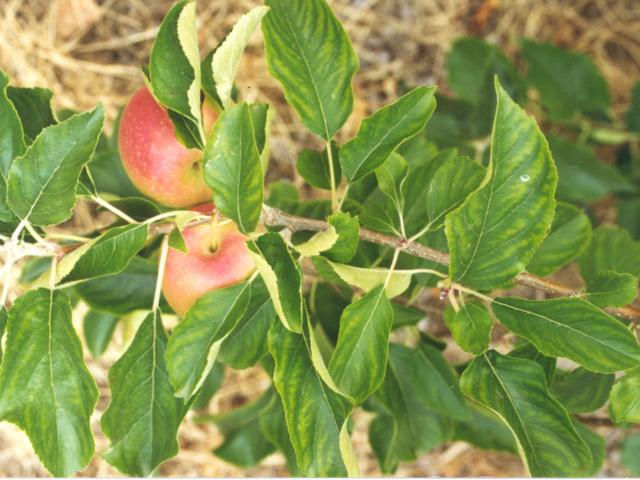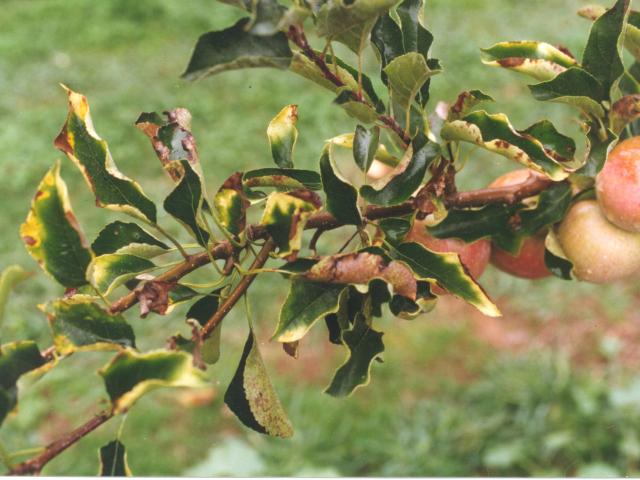Introduction
The trace elements zinc, copper and manganese have been shown to be deficient in Western Australian apple and pear orchards. Adequate uptake of these elements is essential for healthy tree growth and quality fruit production.
Magnesium is not in a true sense a trace element, however, deficiencies are often noted, particularly on young trees.
Zinc deficiency is most widespread, occurring in bearing and non-bearing trees grown on a wide range of orchard soils. Unless corrective measures are taken at planting, tree training can be disrupted and production delayed. Both soil and foliar applications are recommended to established trees to alleviate deficiency symptoms.
Nematode damage to the root system has been associated with low zinc uptake by fruit trees. Correction of zinc deficiency through dormancy and foliar spray applications is extremely difficult. Copper and/or manganese deficiency, which may be more prevalent on the lighter sandy and gravelly soil types, will also impair tree growth, particularly on young trees.
While some leaf nutrient symptoms are easily identifiable, leaf analysis must be used to determine whether there are single, or multiple deficiencies/toxicities contributing to the poor health of trees.
Deficiency symptoms
Symptoms of deficiencies range from failure of buds to shoot, terminal stoppage (zinc or copper), poor leaf size (zinc), leaf rosetting (zinc), yellowing between the leaf veins (zinc or manganese) or around the margins of leaves (manganese and magnesium).
A common general effect on young trees is reduced shoot growth or stunted leader growth with multiple shooting from the base of the tree. On bearing trees, canopy growth and yields may be seriously affected.
Zinc
Zinc deficiency can result in dieback of leaders or shortened internodes and small leaves ('little leaf') at shoot extremities, resulting in a bushy or 'rosette' appearance to shoot tips. Other symptoms include the delay or even failure of buds to shoot and early defoliation. The reduced size of leaves is usually associated with bright yellowing between the veins, known as interveinal chlorosis. Affected leaves are more pointed than normal. Low zinc uptake may reduce tree health and yields, even though there are no obvious visual symptoms.
Copper
Copper deficiency can be a major problem with establishment of young trees. It is readily recognisable by speckling of leaves on shoot tips and, in extremely deficient cases, by the cessation of terminal shoot growth resulting in a condition known as 'wither tip'.
Affected young shoots bend down readily, shrivel and die. New shoots emerge lower in the tree, producing a 'witch's broom' appearance at the regrowth point.
Manganese
Manganese deficiency is typically seen as pale areas on the leaf between darker green veins. The interveinal colour is pale green rather than bright yellow as with zinc. Affected leaves are usually the older, most shaded leaves on fruiting spurs. Leaf shape remains normal. Manganese deficiency may be found in most fruit growing districts.
Manganese availability is increased in highly acidic soils and under waterlogged soil conditions. Symptoms may include necrotic spots, or measles, on (or under) the bark. This may be associated with poor growth, or even dieback in severe cases.
Magnesium
Magnesium deficiency produces a distinct yellowing of the leaf tip and margin with a characteristic, dark green arrow tip effect, showing from the leaf base. With severe deficiency, marginal leaf scorch can also occur. The deficiency is most commonly seen on older leaves. Young, vigorous trees exhibit the symptom in the middle to the end of the season.
Determining status of trees and soils
The magnesium and trace element status of fruit trees should be determined by chemical analyses of mid-shoot leaves sampled in January and February. Standards are available to interpret these results. Comparative sampling of the youngest fully emerged leaves (approximately five leaves back from the growing tip) from healthy and unhealthy trees can be used at any time of the growing season.
Misleading results may be obtained, if leaves have been sprayed with foliar nutrients and/or fungicides. Soil analysis does not provide a reliable guide to the trace element status of the soil for fruit growing. This is particularly so for analyses of surface soil to a depth of 10 or 15 centimetres. Most feeder roots are found between 10 and 30 centimetres deep, depending on soil type and rootstock. Tree roots, however, will explore a large volume of soil in search of nutrients and water.
Corrective treatments
Correcting trace element deficiencies in trees using both soil and foliar-applied sources can be difficult and it may take several years before results may be apparent in tree growth on mature trees.
Spray treatments
Foliar sprays may be an effective way of correcting some trace element deficiencies. Sprays are best applied in early to mid-summer, with three to four applications required each year. The rate and number of applications will depend on the product specifications and the degree of deficiency of the trace element to be corrected.
Dormant sprays, using higher rates of chemicals, are useful supplements where leaf analysis has identified a severe deficiency. Dormant spraying is best carried out in July to early August, preferably before or two weeks after application of a winter oil spray.
Generally it is not recommended to apply any trace element sprays in the first four weeks of fruit development. Growers must read labels carefully, as some products applied at the wrong growth stage may result in fruit russeting.
The following recommendations are for sulphate-based trace element sources. The recommendations should be used as a guide only, and their effectiveness in improving tree growth monitored regularly after product application. Spray grade formulations of any sulphate should always be applied in foliar sprays in preference to fertiliser grade products.
Foliage sprays
Spring and early summer
Copper: Where a deficiency occurs in young non-bearing trees apply an un-neutralised (no lime added) spray of copper sulphate at 50g/100L with addition of an approved wetting agent. Apply to runoff. A supplementary surface dressing may also be considered (see surface dressings following).
Zinc: Zinc sulphate can be applied to the foliage of non-bearing trees only at the rate of 150g/100L (+ wetting agent). Fruit russeting can result from application to bearing trees. Zinc sulphate can be applied as a defoliant spray in autumn at the rate of 2kg/100L.
Zinc and magnesium: For young non-bearing trees, apply zinc sulphate (150g/100L) plus a spray grade formulation of manganese sulphate (250g/100L) together with a wetting agent. Fruit russeting can result from application to bearing trees.
Magnesium: Apply magnesium sulphate (Epsom salts) at 1kg/100L plus a wetting agent, when symptoms are identified. A late summer spray is recommended where leaf magnesium deficiency symptoms have developed, or if leaf analysis has shown a serious deficiency. Complete spraying before leaf fall.
Dormancy
Sprays during dormancy are supplementary to spring and summer sprays where leaf analysis has shown one or more elements to be deficient. Spray in fine weather, concentrating on the upper two-thirds of the tree to saturate the bark. Spray before, or two weeks after, a winter oil application. Single nutrient sprays listed below can be mixed. Note that high concentrations of copper sulphate can damage some spray pump components.
Copper: Apply copper sulphate at 500g/100L.
Zinc: Apply zinc sulphate at 2–5kg/100L. Spray immediately after pruning.
Manganese: Apply the spray grade formulation of manganese sulphate at 4kg/100L.
Zinc and manganese: Apply zinc sulphate (2.5kg/100L) and spray grade formulation of manganese sulphate (2.5kg/100L) together with a wetting agent.
Nutrients in fungicides
Sulphates are not the only formulations containing trace elements. Many of the commonly applied fungicides also contain high concentrations of trace elements as part of their formulations. Examples are:
Copper: Copper oxychloride® (approx 59% copper) and Kocide® (approx 65% copper)
Manganese: Mancozeb® (16% manganese)
Zinc: Ziram® (20% zinc). Metiram® (16% zinc) and Mancozeb® (2% zinc).
While most fungicides are formulated to remain on the leaf surface, it is recognised that some of the trace element fraction may eventually be taken up by the plant through leaf stomatal openings. This could contribute to overcoming a low trace element status in the tree, but these products should not be used as the sole source of trace elements to correct a known deficiency.
New products
New products using different formulations (often chelates) are continually entering the market and should be assessed for their nutrient content and purpose before being applied in the orchard.
Surface dressings
Trace elements have restricted downward movement if applied to the surface of most soils. Therefore, they are best incorporated into the soil prior to planting, particularly in areas with a history of trace element deficiencies. Chelates are said to be more mobile in soil than sulphates.
Heavy applications of lime may restrict availability of trace elements if the soil pH is adjusted above pH 7 (CaCl2 extract). Soil pH testing is essential to assist in decisions on the need for, and rate of, lime prior to application.
Deep banding, or incorporation as close to the tree line as possible without major root damage occurring, may be the best approach where trace element deficiencies are detected in established trees. This should be kept to a depth of 10 to 15 centimetres for minimal root disruption.
Applications in late winter or early spring are recommended. Surface applications of zinc oxide, or zinc sulphate (through the irrigation), were not found to be effective in correcting zinc deficiency in mature apple trees. Both products, therefore, should be ripped into the rootzone to have any chance of supplying zinc to the trees. A combination of both soil and foliar applications should be applied at rates and times expressed in this publication, in an attempt to correct zinc deficiency.
Copper: Apply copper sulphate at rates from 250g per tree depending on tree size. The dressings should be spread out around the tree within a 1.5–2m radius from tree butts. Normally best applied in early August and incorporated into the soil where possible.
Magnesium: Apply magnesium sulphate (Epsom salts) at rates from 500g for young trees to 2kg for large trees, as for copper sulphate, or in a strip for hedgerow plantings.
Zinc and manganese: Apply pre-plant where possible at depth. Use superphosphate pre-plant blend below. Zinc and manganese may be applied separately, or in combination, at the rate of 3kg of manganese sulphate and 2kg of zinc oxide per 100m of tree row (half these amounts per 100m of band on each side of the trees).
Pre-plant fertiliser application
Trace elements are generally applied in combination with superphosphate, as the application rates of individual trace elements are very low. As such, a general formulation has been suggested for use in new orchard sites in Western Australia. The composition of this blend is based on field experience and has been shown to aid in the establishment of new tree plantings. The application rate may vary with soil type and previous fertiliser history.
| Superphosphate | 1.5t |
| Magnesium sulphate (Epsom salts)# | 250kg |
| Manganese sulphate (agricultural grade) | 100kg |
| Copper sulphate | 50kg |
| Zinc oxide* | 100kg |
# Magnesium may also be applied separately as dolomite lime (about 10-12% Mg). Magnesium sulphate may be deleted from the initial blend and applied through the irrigation, if required, after planting.
* Zinc sulphate may be substituted for zinc oxide, with approximately 350kg of zinc sulphate required to supply the equivalent amount of zinc.
This blend should be topdressed along the proposed tree rows in a 2 metre wide strip, followed by deep cultivation, four to five weeks before planting. Application rates per metre of row length can be calculated on a per tree basis.
For example, at 1000 trees/ha and 2t/ha of the above blend, each tree should receive the equivalent of 2kg of fertiliser. If the row widths were 5 metres, then trees would be planted at 2 metre intervals down the row. The area over which 2kg would be applied would be 4 square metres per tree (that is, 2m wide x 2m length of row).
The approximate percentages of trace elements in common sources are shown below. Percentages will vary with the purity of the source.
| Source | Cu% | Zn% | Mn% | Mg% |
|---|---|---|---|---|
| Copper sulphate | 25 | |||
| Copper oxysulphate | 15 | |||
| Zinc sulphate | 22 | |||
| Zinc oxysulphate | 15 | |||
| Zinc oxide | 80 | |||
| Manganese sulphate | 30 | |||
| Magnesium sulphate | 9.5 |
Some fertiliser resellers can now prepare blends to grower specifications.
Acknowledgement
Information on application rates and fertiliser blends are based on those initially proposed by Mr NH Shorter and Mr JEL Cripps, former employees of the Department of Agriculture and Food.






